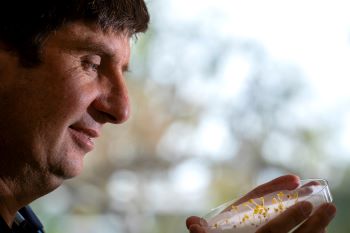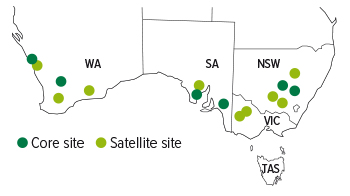A national project is shining a light on key factors that influence the establishment of canola with an aim to provide a guidebook for growers to improve the crop’s reliability and performance.
Although it is a very-high-value crop for Australia, canola is regarded as riskier to produce due to greater seed costs and increased fertiliser demand compared to cereals. Successful establishment is key to setting up a canola crop, and tips and tactics for growers to support better establishment are being developed in a new national GRDC-supported project.
Project lead Dr Andrew Fletcher from CSIRO says reducing the risks of poor canola establishment under marginal seedbed conditions offers prospects of increasing grower profitability. Poor canola establishment costs the industry more than $100 million per year. This project aims to increase canola establishment by 25 per cent across Australia by understanding the factors resulting in poor establishment and providing guidelines for how to overcome them.
“The four-year project commenced in early 2023. We have taken a comprehensive approach to setting up this research, which incorporated an extensive literature review, an online industry survey and direct industry consultation to design the investigative field trials,” Dr Fletcher says.
 Dr Andrew Fletcher from CSIRO is leading a national team that is taking a deep dive into investigating factors that affect canola establishment to ultimately improve yields. Photo: Evan Collis
Dr Andrew Fletcher from CSIRO is leading a national team that is taking a deep dive into investigating factors that affect canola establishment to ultimately improve yields. Photo: Evan Collis
“The literature review identified key research opportunities. Firstly, to improve the understanding of how soil moisture and temperature interact to reduce establishment when sowing early. Secondly, to investigate the impact of sowing depth on canola establishment and the ability to ‘moisture-seek’ or evade high temperatures with deeper sowing. Thirdly, to consider the impact of crop residue/stubble on establishment under early sowing and, finally, to determine the effect of soil crusting.”
An online survey captured responses from 126 respondents across the key canola growing regions in Australia. The results showed that growers generally aim for 20 to 40 plants per square metre and were achieving estimated field establishment rates of 60 to 80 per cent.
The issues identified in the survey that contribute to poor canola establishment were complex and for ease of illustration have been presented in a word cloud. The size of the issue in this cloud indicates the number of respondents that registered the issue.
Seeding depth, followed by marginal soil moisture, furrow infill, surface crusting and stubble/residue issues were considered the major issues impacting canola establishment.
Together with further industry consultations, four consistent themes emerged from this groundwork to shape the research:
- Critical soil moisture and temperature thresholds and tools are needed to help growers make decisions about successful seeding conditions, especially with early seeding.
- More information on optimum sowing depths under different conditions is required, particularly in the context of early seeding.
- The impact of stubble on moisture retention, temperature and canola establishment should be re-examined.
- The impact of factors leading to soil crusting and contributing factors needs more research.
Dr Fletcher says an understanding of canola growth and development is necessary to focus the necessary research (Figure 1).
Figure 1: Key growth stages that will be investigated between sown seed and establishment in canola.

Source: GRDC
“Seed dormancy, seed size, composition, type of germination, vigour, hypocotyl length and strength and radicle elongation all influence canola establishment,” Dr Fletcher says.
“Unlike cereals, canola pushes its seed above ground when it germinates, requiring energy and significant force to break through the soil surface. In contrast, cereal seeds remain in the ground and the crop emerges via elongation of the coleoptile.”
Canola seed is small – approximately one-tenth the size of wheat – and is composed of oil and protein, which are slow to metabolise for an emerging seedling. Cereal grains are high in carbohydrate, which is a readily available source of energy for an emerging plant.
“However, canola does have an advantage as we have access to hybrid types that have larger seed size that exhibit improved germination and establishment compared to open-pollinated types.”
The hypocotyl is the connecting structure between the root and the cotyledons and previous GRDC-supported CSIRO research has shown that there are genetic differences in the length of the hypocotyl. Longer hypocotyls could improve canola emergence, particularly from depth).
“Environment and management aspects can also affect canola emergence and the literature review indicated sowing date, soil moisture, soil temperature, sowing depth, density and stubble issues will be high-priority issues.
“In Australia, canola is usually the first crop sown in a seeding program to maximise yield potential (this includes dry sowing) and with the increasing size of cropping programs growers will often sow canola into marginal seedbed conditions.”
From the literature, survey and industry consultation groundwork, Dr Fletcher says an integrated approach is being applied to the research to capture and leverage the interactions of genetics by environment by management (GxExM).
Integrated research approach
The project has a national mandate and involves nine partners and 15 core and satellite field sites that have been set up across the country covering different rainfall zones and soil types (Figure 2).
Figure 2: Map of core and satellite canola establishment trial sites across Australia for the project
Source: CSIRO
The team includes CSIRO, EPAG Research, the Western Australian Department of Primary Industries and Regional Development, the New South Wales Department of Primary Industries, Living Farm, Birchip Cropping Group, Brill Ag, AgGrow, Grain Orana Alliance and AgInnovate.
“Combinations of novel approaches and technologies – for example genetic innovation in long hypocotyl, avoiding secondary seed dormancy, precision seeding technologies, seed treatments, addressing soil water repellence and soil surface crusting – are more likely to deliver reliable canola establishment through additive effects, as opposed to on their own,” Dr Fletcher says.
To evaluate and optimise combinations of GxExM components a range of activities including desktop analysis, glasshouse and field experiments coupled with modelling have been put in train across Australia.
Six core research sites will be maintained at Geraldton and Merredin in WA, Wynarka and Ungarra in South Australia and Condobolin and Canowindra in NSW. Whilst three satellite sites per state will focus on regional farmer practices to improve establishment.
The core experiments are using combinations of sowing date, irrigation and soil covering to identify critical thresholds of soil moisture and temperature to maximise establishment. Detailed measurements of soil moisture and temperature are being collected.
A surprising finding from these experiments in 2023 was the high (exceeding 40°C) midday soil temperatures at typical canola sowing depths when sown early in April. These high temperatures inhibited germination and emergence. However, soil temperatures were cooler at other times of the day.
The implications of this diurnal variation in temperature are being investigated. The experiments also tested whether deeper sowing could be used to chase soil moisture and avoid high temperatures.
The project is also using detailed controlled-environment studies in the laboratory to monitor germination under a range of high soil temperatures and moisture contents to develop hydrothermal models for canola establishment at high temperatures and low soil moisture. These hydrothermal models will then be compared with field results to develop critical moisture and temperature thresholds.
Extension activities will be run for all three seasons of the project that will include grower updates and field walks to discuss the outcomes of the research. Resources, including a decision tree, will be developed for growers and advisers to assist in adoption of the identified practices that overcome constraints and risks to reliable canola establishment.
More information: Dr Andrew Fletcher, andrew.fletcher@csiro.au

























































